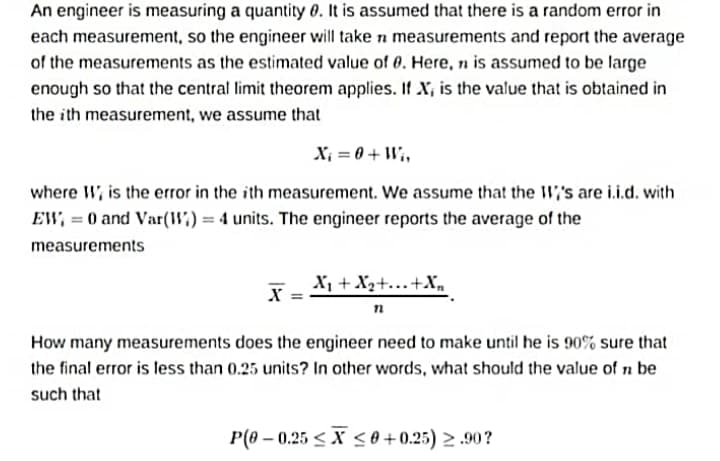An engineer is measuring a quantity 0. It is assumed that there is a random error in each measurement, so the engineer will take n measurements and report the average of the measurements as the estimated value of 0. Here, n is assumed to be large enough so that the central limit theorem applies. If X, is the value that is obtained in the ith measurement, we assume that X; = 0 + W, where W, is the error in the ith measurement. We assume that the W,'s are i.i.d. with EW, = 0 and Var(") = 4 units. The engineer reports the average of the measurements X, + X2+...+X, X = How many measurements does the engineer need to make until he is 90% sure that the final error is less than 0.25 units? In other words, what should the value of n be such that P(0 – 0.25 < X <0 + 0.25) 2 .90?
An engineer is measuring a quantity 0. It is assumed that there is a random error in each measurement, so the engineer will take n measurements and report the average of the measurements as the estimated value of 0. Here, n is assumed to be large enough so that the central limit theorem applies. If X, is the value that is obtained in the ith measurement, we assume that X; = 0 + W, where W, is the error in the ith measurement. We assume that the W,'s are i.i.d. with EW, = 0 and Var(") = 4 units. The engineer reports the average of the measurements X, + X2+...+X, X = How many measurements does the engineer need to make until he is 90% sure that the final error is less than 0.25 units? In other words, what should the value of n be such that P(0 – 0.25 < X <0 + 0.25) 2 .90?
Mathematics For Machine Technology
8th Edition
ISBN:9781337798310
Author:Peterson, John.
Publisher:Peterson, John.
Chapter29: Tolerance, Clearance, And Interference
Section: Chapter Questions
Problem 11A
Related questions
Question

Transcribed Image Text:An engineer is measuring a quantity 0. It is assumed that there is a random error in
each measurement, so the engineer will take n measurements and report the average
of the measurements as the estimated value of 0. Here, n is assumed to be large
enough so that the central limit theorem applies. If X, is the value that is obtained in
the ith measurement, we assume that
X; = 0 + W,,
where W, is the error in the ith measurement. We assume that the W,'s are i.i.d. with
EW, = 0 and Var(") = 4 units. The engineer reports the average of the
measurements
X, + X2+..+X,
X =
How many measurements does the engineer need to make until he is 90% sure that
the final error is less than 0.25 units? In other words, what should the value of n be
such that
P(0 – 0.25 < X < 0 + 0.25) > .90?
Expert Solution
This question has been solved!
Explore an expertly crafted, step-by-step solution for a thorough understanding of key concepts.
This is a popular solution!
Trending now
This is a popular solution!
Step by step
Solved in 3 steps with 3 images

Follow-up Questions
Read through expert solutions to related follow-up questions below.
Follow-up Question
can you explain ? thank you !

Transcribed Image Text:By our discussion above, the 95% Confidence
interval for 0 = Ex; is given by
6
(x - 2 € √ X + 25 ²5 ).
-
ท
Solution
Recommended textbooks for you

Mathematics For Machine Technology
Advanced Math
ISBN:
9781337798310
Author:
Peterson, John.
Publisher:
Cengage Learning,

Algebra & Trigonometry with Analytic Geometry
Algebra
ISBN:
9781133382119
Author:
Swokowski
Publisher:
Cengage


Mathematics For Machine Technology
Advanced Math
ISBN:
9781337798310
Author:
Peterson, John.
Publisher:
Cengage Learning,

Algebra & Trigonometry with Analytic Geometry
Algebra
ISBN:
9781133382119
Author:
Swokowski
Publisher:
Cengage
